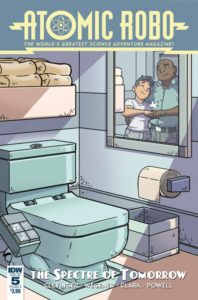
Atomic Robo: The Spectre of Tomorrow # 5
Writer: Brian Clevinger
Artist: Scott Wegener
Publisher: IDW Comics
Review by Sean Frankling
 In Atomic Robo: The Spectre of Tomorrow #5, Nikola Tesla’s mechanical son faces his two deadliest enemies combined into one sinister superpower. If you’ve never read this series before, it follows Robo, an automatic intelligence built by Tesla himself in the 1920s. With his action science company, Tesladyne, he leads the cutting edge of science and punches things a lot. In this conclusion of the current arc, he faces the Nazi super scientist Helsingard, who has taken over the consciousness of Alan, a malevolent AI bent on expanding to fill the universe.
In Atomic Robo: The Spectre of Tomorrow #5, Nikola Tesla’s mechanical son faces his two deadliest enemies combined into one sinister superpower. If you’ve never read this series before, it follows Robo, an automatic intelligence built by Tesla himself in the 1920s. With his action science company, Tesladyne, he leads the cutting edge of science and punches things a lot. In this conclusion of the current arc, he faces the Nazi super scientist Helsingard, who has taken over the consciousness of Alan, a malevolent AI bent on expanding to fill the universe.
As much as that all is the recipe for some very exciting robot-punching action, this is actually one of the less satisfying conclusions in Atomic Robo‘s history. As an end to the arc, it just doesn’t tie off the thematic threads.
The action art in this issue carries all the fun and fury that’s typical of an Atomic Robo story. When robot punches land and explosions go off, you can almost feel the vibrations shuddering off the page. That said, there’s also definitely a looser feel to the drawings in this issue than there has been in the past. Wegener’s art has been getting more cartoonish for a while. And that’s been a good thing for the most part. It’s built on the fun and friendly look of the comic and added expressiveness to its characters. In this one, though, that cartoonish quality sometimes comes at the expense of fine detail in character models. It’s not enough to ruin the otherwise superb aesthetic, but it can be a little distracting.
The first four issues of this arc built up some intriguing questions about transhumanism and the role of artificial intelligence. How much of a threat do machines pose when we can’t distinguish them from humans? How do we distinguish between beneficial growth of artificial intelligence and malevolent expansion? Unfortunately, this issue ends the arc on a straight-up punch-out, which means the series never gives us the answers it’s been teasing us with.
On the other hand, though, this issue does give us an interesting subversion of the usual AI villain story arc. Helsingard, a human brain in a robot body, subjugates the fully artificial Alan and thereby becomes a bigger threat than either of them alone. So it’s actually the human evil that presents the greatest threat here, not the pure machine. And Robo’s presence as the series’ hero means that it’s another machine — a good machine — that saves us from him.
There’s also some redemption for the disappointing conclusion in a startling reveal on this issue’s last page. Without spoiling exactly what it is, it offers some fertile ground for the next arc after this one. And if Wegener and Clevinger play it right, it has lots of opportunities to explore the themes left behind this issue.
Verdict:
Wait and See. Atomic Robo is one of my favourite series of all time. A big reason why is its clever use of science fact — often engaging questions about the philosophy of high tech. This issue doesn’t do that as well as some. Still, it seems like the creators are ramping up for something bigger. I think it’ll be worth seeing what.



